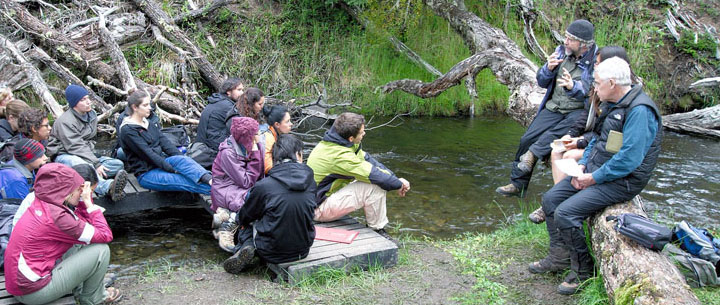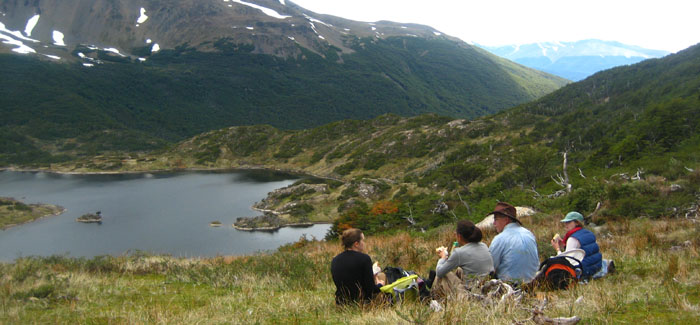 Tracing Darwin's Path is an interdisciplinary course that works to join philosophy and biology in an endeavor to facilitate various goals of biocultural conservation at Omora Ethnobotanical Park in Southern Chile. For the past two years, the University of North Texas, in collaboration with the University of Magallanes, Chile, and OSARA have been holding hold classes in the Omora Ethnobotanical Park.
Tracing Darwin's Path is an interdisciplinary course that works to join philosophy and biology in an endeavor to facilitate various goals of biocultural conservation at Omora Ethnobotanical Park in Southern Chile. For the past two years, the University of North Texas, in collaboration with the University of Magallanes, Chile, and OSARA have been holding hold classes in the Omora Ethnobotanical Park.
In an effort to understand both the biological and cultural components of the conservation project, the course was broken into two classes. The first was a biology class on the freshwater aquatic invertebrates of the Robola Watershed, taught by Professor Kennedy and Ph.D candidate Tamara Contador. The philosophy class, taught by Professor Rozzi, was further broken down into the miniature forest group and the ethno-zoology group. I myself was enrolled in the ethno-zoology group that focused on birds. Our project essentially was to learn about the indigenous Yagan culture, the significance of birds within their culture, and how we can use that significance in terms of environmental conservation.
The Yagans connect birds to the land and to all living things--linking society and the natural environment. The interconnectedness of peoples, animals, and plants plays an important role when determining conservation plans, as the interrelationships between them form the entire ecology.
Some of my favorite memories of the trip take place camping. After walking all day, setting up camp, bird watching, and various other activities, the whole group would gather next to the fire at the end of the day to process and discuss our experiences and philosophical ideas. Listening to Yagan stories and relating them to environmental ethics was engaging and thought provoking, especially when both the philosophy and biology groups were present. Music accompanied our discussions, for me, creating a bonding experience to both the people within the group as well as to the surroundings.
 While participating in this unique class, I received a life lesson that I hold extremely valuable. I learned that the ability to work with people coming from different perspectives is difficult yet crucial. Over half of our group was part of an aquatic entomology team studying diverse life processes in local streams, while the other half was studying the interconnection of nature and living creature and the ethics involved in conservation. The two groups represented pieces of the same puzzle--together creating a larger picture. Communication became an essential part of merging the two groups, and finding ways to communicate ideas was a continuous challenge we still face today. I came to believe that communication is important as it connects people to a shared goal, and through integration the group propels forward.
While participating in this unique class, I received a life lesson that I hold extremely valuable. I learned that the ability to work with people coming from different perspectives is difficult yet crucial. Over half of our group was part of an aquatic entomology team studying diverse life processes in local streams, while the other half was studying the interconnection of nature and living creature and the ethics involved in conservation. The two groups represented pieces of the same puzzle--together creating a larger picture. Communication became an essential part of merging the two groups, and finding ways to communicate ideas was a continuous challenge we still face today. I came to believe that communication is important as it connects people to a shared goal, and through integration the group propels forward.
Beyond what is mentioned above, the course provides creative expression and freedom to seek educational opportunities. It is a bonding experience with nature, animals, fellow students, and teachers. Each student is able to bring something to the class to help it grow stronger; creating a more connected and integrated class for the future.
Contributor: Kassandra Petr, Social Sciences, UNT 2008

